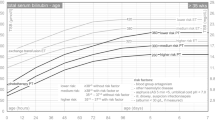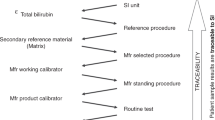Abstract
Objective:
To assess the utility of measuring direct bilirubin (DB) during the first 72 h of life in infants admitted to the neonatal intensive care unit (NICU).
Study design:
Infants born between May 2006 and June 2013, and admitted to the NICU were included. Abnormal DB was defined as: DB level⩾1 mg dl−1 with a corresponding TB of ⩽5 mg dl−1 or DB level >20% of the corresponding TB>5 mg dl−1.
Results:
The DB levels were measured in 3715 infants during the first 72 h of life. Sixty-three infants (1.7%) had abnormal DB. In a number of infants with potentially treatable diseases (biliary atresia and choledochal cyst), the only abnormal finding was a mildly elevated DB (1 to 2 mg dl−1) during the first 3 days of life. In 22 infants (35%), the cause for high DB was unknown (16%) or not investigated (19%).
Conclusions:
Routine measurement of DB in neonates admitted to NICU may be helpful in identifying potentially treatable causes of cholestasis.
This is a preview of subscription content, access via your institution
Access options
Subscribe to this journal
Receive 12 print issues and online access
$259.00 per year
only $21.58 per issue
Buy this article
- Purchase on Springer Link
- Instant access to full article PDF
Prices may be subject to local taxes which are calculated during checkout

Similar content being viewed by others
References
Maisels MJ . What's in a name? Physiologic and pathologic jaundice: the conundrum of defining normal bilirubin levels in the newborn. Pediatrics 2006; 118 (2): 805–807.
American Academy of Pediatrics Subcommittee on Hyperbilirubinemia. Management of hyperbilirubinemia in the newborn infant 35 or more weeks of gestation. Pediatrics 2004; 114 (1): 297–316.
Moyer V, Freese DK, Whitington PF, Olson AD, Brewer F, Colletti RB et al. Guideline for the evaluation of cholestatic jaundice in infants: recommendations of the North American Society for Pediatric Gastroenterology, Hepatology and Nutrition. J Pediatr Gastroenterol Nutr 2004; 39 (2): 115–128.
Herzog D, Chessex P, Martin S, Alvarez F . Transient cholestasis in newborn infants with perinatal asphyxia. Can J Gastroenterol 2003; 17 (3): 179–182.
Fischler B, Lamireau T . Cholestasis in the newborn and infant. Clin Res Hepatol Gastroenterol 2014; 38 (3): 263–267.
Dick MC, Mowat AP . Hepatitis syndrome in infancy—an epidemiological survey with 10 year follow up. Arch Dis Child 1985; 60 (6): 512–516.
Knisely AS . Biliary atresia and its complications. Ann Clin Lab Sci 1990; 20 (2): 113–118.
Powell JE, Keffler S, Kelly DA, Green A . Population screening for neonatal liver disease: potential for a community-based programme. J Med Screen 2003; 10 (3): 112–116.
Harpavat S, Finegold MJ, Karpen SJ . Patients with biliary atresia have elevated direct/conjugated bilirubin levels shortly after birth. Pediatrics 2011; 128 (6): e1428–e1433.
Balistreri WF, Grand R, Hoofnagle JH, Suchy FJ, Ryckman FC, Perlmutter DH et al. Biliary atresia: current concepts and research directions. Summary of a symposium. Hepatology 1996; 23 (6): 1682–1692.
McKiernan PJ . Neonatal cholestasis. Semin Neonatol 2002; 7 (2): 153–165.
Vohra P, Haller C, Emre S, Magid M, Holzman I, Ye MQ et al. Neonatal hemochromatosis: the importance of early recognition of liver failure. J Pediatr 2000; 136 (4): 537–541.
Pan X, Kelly S, Melin-Aldana H, Malladi P, Whitington PF . Novel mechanism of fetal hepatocyte injury in congenital alloimmune hepatitis involves the terminal complement cascade. Hepatology 2010; 51 (6): 2061–2068.
Walsh-Sukys MC, Cornell DJ, Stork EK . The natural history of direct hyperbilirubinemia associated with extracorporeal membrane oxygenation. Am J Dis Child 1992; 146 (10): 1176–1180.
Abbasi S, Stewart DL, Radmacher P, Adamkin D . Natural course of cholestasis in neonates on extracorporeal membrane oxygenation (ECMO): 10-year experience at a single institution. ASAIO J 2008; 54 (4): 436–438.
Shneider B, Cronin J, Van Marter L, Maller E, Truog R, Jacobson M et al. A prospective analysis of cholestasis in infants supported with extracorporeal membrane oxygenation. J Pediatr Gastroenterol Nutr 1991; 13 (3): 285–289.
Davis AR, Rosenthal P, Escobar GJ, Newman TB . Interpreting conjugated bilirubin levels in newborns. J Pediatr 2011; 158 (4): 562–565 e561.
Acknowledgements
This work was supported by the Institutional Development Award (IDeA; Aghai) from the National Institute of General Medical Sciences of the National Institutes of Health under grant number U54-GM104941 (PI: Binder-Macleod) and NIH COBRE P30GM114736 (PI: Thomas H Shaffer).
Author information
Authors and Affiliations
Corresponding author
Ethics declarations
Competing interests
The authors declare no conflict of interest.
Rights and permissions
About this article
Cite this article
Sloane, A., Nawab, U., Carola, D. et al. Utility of measuring direct bilirubin at first 72 h of age in neonates admitted to the neonatal intensive care unit. J Perinatol 37, 536–540 (2017). https://doi.org/10.1038/jp.2016.259
Received:
Revised:
Accepted:
Published:
Issue Date:
DOI: https://doi.org/10.1038/jp.2016.259
This article is cited by
-
Direct hyperbilirubinemia in newborns with gastroschisis
Pediatric Surgery International (2019)
-
Newborn screening for biliary atresia in the United States
Pediatric Surgery International (2017)



